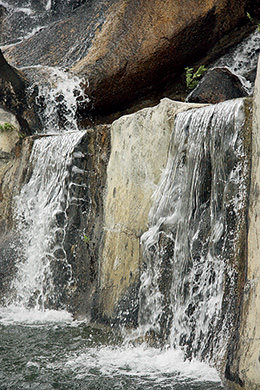Shutter speed refers to the length of time a camera's shutter is open to expose light into the camera sensor when taking a photograph, giving you full control of how you want to capture moving subjects. (Reported by: Ryosuke Takahashi)

The Principles & Effects of Shutter Speed
Shutter speed can affect your image
When a fast shutter speed is used, it can help freeze action completely. When a slow shutter speed is used, an effect called "motion blur" is created, to express an effect of motion in the image.
Besides affecting how the movement of the subject appears in a photo, shutter speed also controls the length of time the image sensor is exposed to light, which in turn determines the amount of exposure. In order for the amount of light falling on the image sensor surface to remain constant, the aperture needs to be stopped down if you want the shutter to remain open for a longer period of time. On the other hand if the shutter speed is increased, the aperture needs to be opened more widely to capture more light. In summary, shutter speed is closely related to the aperture value, and is an important element that makes up a photo.
Fast Shutter Speed

Aperture-priority AE (f/5.6, 1/4000 sec.)
At the speed of 1/4000 second, both the movement of the players as well as that of the sand in the air appears frozen.
Slow Shutter Speed

Shutter-priority AE (f/8, 2 sec.)
In this example, the shutter is left open for two seconds. Long trails are created by the headlight and taillight of the cars.
Changes in Photo Expression with Shutter Speed
From the examples below, we can tell that the length of the shutter speed greatly affects the impression of a photo. The waterfall appears dynamic when it is captured at a fast shutter speed (sample photo below taken at 1/400 sec.), while motion blur that occurs at a slow shutter speed creates a peaceful atmosphere (sample photo below taken at 0.5 sec.).

At 1/400 sec.

At 0.5 sec.
You can control how you want to express the motion of a moving subject with shutter speed. A fast shutter speed has the effect of freezing motion, while a slow shutter speed can be made use of to express movement by creating motion blur in the subject.
Combine a fast shutter speed with the continuous shooting mode




A fast shutter speed comes in handy when you are capturing an object with vigorous movements. In the example here, I combined the use of the continuous shooting mode with a fast shutter speed to express the dynamic movement in a series of continuous shots. The result is intriguing, with continuity seen not only in the motion of the boat, but also in that of the splashing waves.

Born in Aichi in 1960, Takahashi started his freelance career in 1987 after working with an advertising photo studio and a publishing house. Photographing for major magazines, he has travelled to many parts of the world from his bases in Japan and China. Takahashi is a member of the Japan Professional Photographers Society (JPS).

































